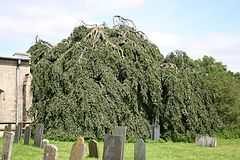Walcot, Lincolnshire
| Walcot | |
 Weeping beech over St Nicholas Church, Walcot |
|
 Walcot |
|
| OS grid reference | TF061351 |
|---|---|
| – London | 95 mi (153 km) S |
| District | North Kesteven |
| Shire county | Lincolnshire |
| Region | East Midlands |
| Country | England |
| Sovereign state | United Kingdom |
| Post town | SLEAFORD |
| Postcode district | NG34 |
| Police | Lincolnshire |
| Fire | Lincolnshire |
| Ambulance | East Midlands |
| EU Parliament | East Midlands |
| UK Parliament | Sleaford and North Hykeham |
|
|
Coordinates: 52°54′11″N 0°25′26″W / 52.903104°N 0.423928°W
Walcot is a village and civil parish in the North Kesteven district of Lincolnshire, England. It lies 1 mile (1.6 km) west from the A15, 7 miles (11 km) south from Sleaford, 9 miles (14 km) east from Grantham, and 1 mile north from Folkingham.
History
Walcot is a probable site of prehistoric or Roman settlement. Earthworks indicating rectilinear ditched enclosures and a circular dwelling have been found, evidenced through crop marks and aerial photographs.[1] Medieval ridge and furrow field systems have also been recorded.[2]
In the Domesday account the village is written as “Walecote”. In 1086 it consisted of 6 villagers, 14 freemen and 5 smallholders, land for 6 plough teams, a 30 acres (0.12 km2) meadow and a church. In 1066 lordship of the manor was held by the Abbey of St Peter, Peterborough, being transferred to Gilbert de Ghent in 1086.[3][4][5]
Marrat, in his History of Lincolnshire (1816), notes the village as being in the wapentake of Aveland. He mentions the existence of two Elizabethan manor houses, one to the west of the church, belonging to Sir Gilbert Heathcote, the other to the south-east of the church, to Edward Brown. Both Heathcote and Brown were Lord of the Manor and principal landowners.[6]
In 1885 Kelly's Directory noted that the village contained “springs of very pure water… one strongly chalybeate”. Agricultural production in a parish of 1,747 acres (7.07 km2) was chiefly wheat, barley and oats. Village population in 1881 was 149. Lord of the manor and principal landowner was Lord Aveland PC, DL, JP.[7]
Landmarks
Walcot Grade I listed Anglican church is dedicated to St Nicholas.[8] It dates from the 12th century, with additions and adaptations up to the 18th, and restorations in 1899, 1907 and 1926. The architectural style is mainly Decorated, the interior being of an earlier, Early English date. It consists of a Perpendicular clerestory, a nave, aisles, and a tower with crocketed broached spire containing 4 bells. In the aisle to the south is a canopied niche with buttresses and pinnacles. In the chancel is a piscina and a priest’s door. Pevsner notes a 17th-century south entrance paneled door incorporating a wicket, and the existence of an 1809 paten by William Fountain.[7][9] Marrat describes two brass plates, to Isaac Lavington (d.1635) and John Lavington (d.1637), in the floor of the north aisle, and gives the patron of St Nicholas' as Sir Gilbert Heathcote.[6] Within the churchyard is a Grade I listed shaft of a 14th-century cross with a later added sundial.[10][11]
Other listed buildings in Walcot are The Grange[12] and Laurel Farm,[13] both late 17th-century and on Main Street, and a barn at Manor Farm.[14]
Civil parish
Although the village is in the civil parish of Walcott near Folkingham local democracy is handled together with the adjacent villages of Newton and Haceby in the Newton, Haceby and Walcot Parish Meeting.[15] [16]
References
- ↑ Historic England. "Monument No. 1042275". PastScape. Retrieved 15 April 2012.
- ↑ Historic England. "Monument No. 1042953". PastScape. Retrieved 15 April 2012.
- ↑ Baron Gilbert de Ghent; Ournorthernroots.com. Retrieved 15 April 2012
- ↑ Walcot in the Domesday Book. Retrieved 15 April 2012.
- ↑ "Documents Online: Walcot near Folkingham, Lincolnshire", Folio: 345v, Great Domesday Book; The National Archives. Retrieved 15 April 2012
- ↑ 6.0 6.1 Marrat, W. (1816); The History of Lincolnshire, Topographical, Historical, and Descriptive; pp. 166-169; reprinted BiblioBazaar, LLC (2010)
- ↑ 7.0 7.1 Kelly's Directory of Lincolnshire with the port of Hull 1885, p. 698
- ↑ Historic England. "Church of St Nicholas (1360637)". National Heritage List for England. Retrieved 15 April 2012.
- ↑ Pevsner, Nikolaus; Harris, John; The Buildings of England: Lincolnshire p.702 ; Penguin, (1964); revised by Nicholas Antram (1989), Yale University Press. ISBN 0300096208
- ↑ Historic England. "Church of St Nicholas (348538 )". PastScape. Retrieved 15 April 2012.
- ↑ Historic England. "Cross in the Churchyard of the Church of St Nicholas, Walcot Near Folkingham (1061738)". National Heritage List for England. Retrieved 15 April 2012.
- ↑ Historic England. "The Grange, Walcot Near Folkingham (1360638)". National Heritage List for England. Retrieved 15 April 2012.
- ↑ Historic England. "Laurel Farm, Walcot Near Folkingham (1061740)". National Heritage List for England. Retrieved 15 April 2012.
- ↑ Historic England. "Barn at Manor Farm, Walcot Near Folkingham (1061739)". National Heritage List for England. Retrieved 15 April 2012.
- ↑ "Newton, Haceby and Walcot Parish Meeting". Parish councils. North Kesteven district council. Retrieved 8 September 2013.
- ↑ "Walcot Near Folkingham CP/AP through time". A Vision of Britain through Time. GB Historical GIS / University of Portsmouth. Retrieved 8 September 2013.
External links
 Media related to Walcot, Lincolnshire at Wikimedia Commons
Media related to Walcot, Lincolnshire at Wikimedia Commons- "Walcot", Genuki.org.uk. Retrieved 15 April 2012
- Walcott weeping beech. Retrieved 15 April 2012
- "History of Walcot Near Folkingham, in North Kesteven and Lincolnshire". A Vision of Britain through Time. GB Historical GIS / University of Portsmouth. Retrieved 8 September 2013.
- "all 19 historical records for the parish". Pastscape. English Heritage. Retrieved 8 September 2013.
| ||||||||||||||||||||||